 |
 |
 |
| |
The HIV Integrase Inhibitor GS-9137
Has Potent Antiretroviral Activity in Treatment-Experienced Patients
|
| |
| |
Andrew R. Zolopa1, Michael Mullen2, Daniel Berger3, Peter Ruane4, Trevor Hawkins5, Lijie Zhong6, Steven L. Chuck6, Jeffrey Enejosa6, Brian P. Kearney6, Andrew K. Cheng6
1Stanford University, Stanford, CA, USA, 2Mount Sinai School of Medicine, New York, NY, USA, 3NorthStar Medical Center, Chicago, IL, USA, 4Light Source Medical, Los Angeles, CA, USA, 5Southwest C.A.R.E., Santa Fe, NM, USA, 6Gilead Sciences, Foster City, CA, USA
Reported by Jules Levin
CROI, LA, Feb 28, 2007
...GS9137 125 mg showed a 2.1 log reduction at week 24 for patients with 1 or more active nukes or first use of Fuzeon...The drug appears to be potent...
authors concluded:
GS-9137 50 mg and 125 mg arms met primary endpoint of non-inferiority for DAVG24
--GS-9137 125 mg group was statistically superior to CPI group for both DAVG16 and DAVG24
GS-9137 125 mg showed potency within two weeks (>2 log10 decrease) that was durable when combined with an active OBT
No difference in incidence or severity of adverse events between CPI and the GS-9137 arms
No dose relationship in Grade 3 or 4 adverse events, laboratory abnormalities, or study drug discontinuation for the GS 9137 arms
Background
Dihydroquinoline carboxylic acid strand transfer inhibitor of HIV integrase
Serum-free IC50 = 0.2 nM; EC90 = 1.2 nM in PBMCs
Active against NRTI-, NNRTI-, and PI-resistant isolates tested
No dose-limiting chronic animal toxicity
Generic name is elvitegravir (el-vye-teg'-ra-vir)
Phase I Clinical Data
Boosted with 100 mg qd ritonavir
-- Half-life of 9-11 hours
-- 20-fold higher systemic exposure
6/6 patients treated with GS-9137 50 mg/ ritonavir 100 mg qd for 10 days had >1.5 log10 copies/mL reductions in HIV RNA (DeJesus E, Berger D, Markowitz M, Cohen C, Hawkins T, Ruane P, et al. J Acquir Immune Defic Syndr 2006;43 (1):1-5.)
Well-tolerated without discontinuations of study drug
Phase II Study Design
Randomized, active-control, partially-blinded (dose of GS-9137), dose-finding study
Initially designed as non-inferiority study of GS-9137 (boosted with 100 mg ritonavir) and boosted PIs in treatment-experienced patients
Optimized Background Therapy (OBT) consisted of nucleos(t)ide reverse
transcriptase inhibitors
- T-20 use was at investigator's discretion
- PI use in GS-9137 arms was initially prohibited
Primary endpoint was time-weighted average change from baseline in HIV RNA through 24 weeks (DAVG24)
Phase 2 Study Schema
*CPI included 49% darunavir, 27% tipranavir
278 patients with HIV >1000 c/ml & with any CD$ count & 1 or more PI mutation received CPI, or 1 of 3 GS9137 doses (20, 50, 125mg).
OBT= NRTIs +/- Fuzeon
NNRTIs not allowed in OBT
Stratified by Fuzeon use in OBT
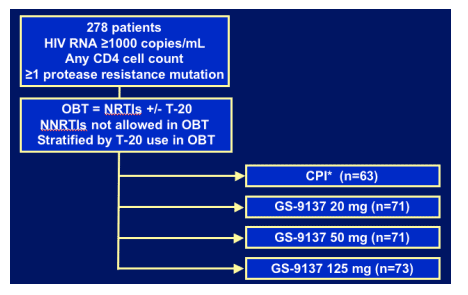
Baseline Characteristics
Mean viral load: 4.5 to 4.7 log.
Mean CD4: 150-180
GSS (genotypic sensitivity score) = 0 for all NRTIs in OBT: 48-51% of patients in all arms.
10-11 protease resistance mutations across all arms.
First use of Fuzeon: 17-24%
Median # ARTs in OBT including Fuzeon: 3
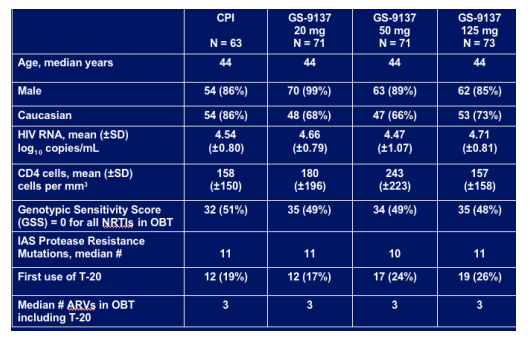
Disposition of Patients
Through Week 24
12-13% across all arms discontinued study.
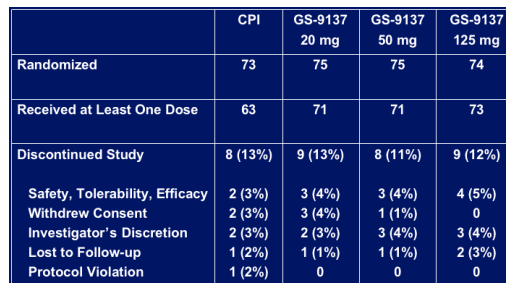
Week 8 DSMB Recommendations
Close GS-9137 20 mg arm due to high rate of virologic failure; patients were offered open-label GS-9137 125 mg
Due to new data indicating lack of drug-drug interactions, permit addition of darunavir or tipranavir to ongoing GS-9137 arms
- Prior to Week 24, 15% of GS-9137 50 and 125 mg patients added a PI
- Only 4 patients added a PI before Week 16: used as latest time for comparison of GS-9137 vs. PI
Primary Endpoint:
Time-Weighted Average Change
from Baseline in HIV RNA (DAVG)
Mean DAVG week 16: -1.2 log for CPI, -1.5 log GS9137 50 mg, -1.7 log GS9137 125 mg.
Mean DAVG week 24: -1.2 log CPI, -1.4 log GS9137 50mg, -1.7 log GS9137 125mg.
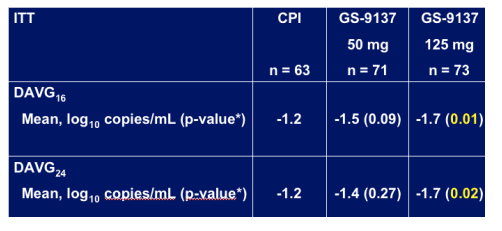
Viral Load Reductions:
Analysis of Per Protocol Sets*
Ever achieved >1 log reduction by week 24: 61% CPI, 91-92% GS9137.
Ever achieved >2 log reduction by week 24: 51% CPI, 69-76% GS9137
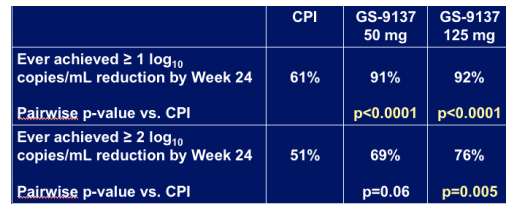
*Data from patients were excluded after switching from CPI to GS-9137 or adding a PI
Change from Baseline in HIV RNA:
ITT Sets
37% of CPI patients switched to GS-9137 beginning at Week 16
GS-9137 20 mg patients switched to open-label GS-9137 125 mg beginning at Week 16 (dashed line)
-- At week 2 the 125mg GS9137 showed a 2 log reduction in viral load which leveled off at about -1.7 log at week 16, and the leveling off is most likely due to weak background therapy.
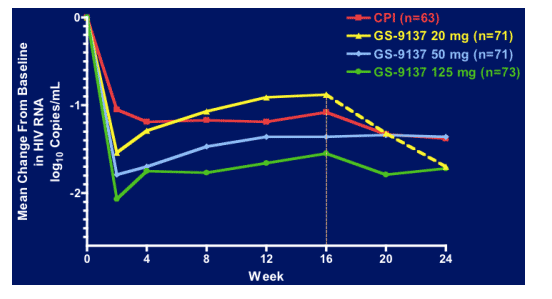
Change from Baseline in HIV RNA
With GS-9137 125 mg:
Influence of Activity of OBT
For patients taking GS9137 & 1 or more active NRTIs or first use Fuzeon in background therapy, there was a -2.1 log reduction at week 24.
Data from GS-9137 125 mg patients after addition of a PI were excluded
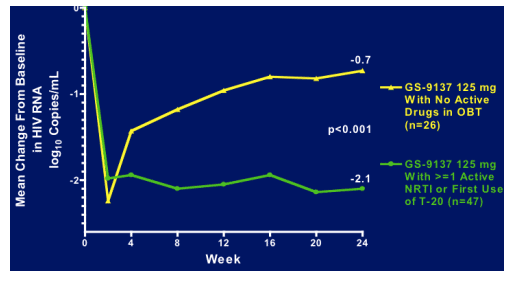
HIV RNA % < 50 Copies/mL
(ITT, M=F)
At week 16, 30% in CPI group, 38% in GS9137 50mg, & 40% in GS9137 125 mg group had <50 c/ml.

Mean Increase in CD4 Cell Counts
(ITT, M=F)
CD4 increased at week 16 by 61 in GS9137 125 mg group, 28 in CPI arm, and 52 in GS9137 50mg arm.

Summary of Adverse Events and Laboratory Abnormalities
21-30% grade 3-4 lab abnormalities across all arms. 13-18% grade 3-4 adverse events. 1-3% adverse events leading to drug discontinuarion.
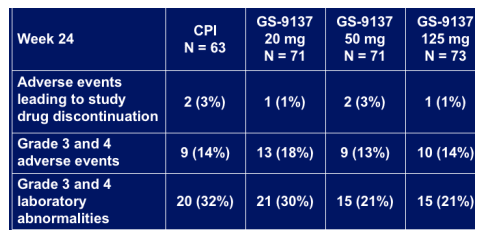
|
| |
|
 |
 |
|
|